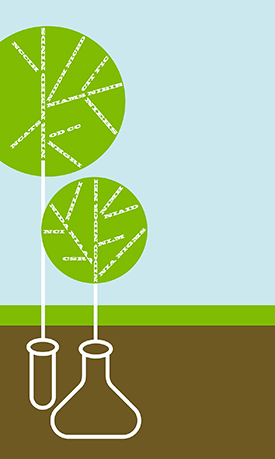News You Can Use
Greening the Scientific Community

Making your lab more environmentally friendly doesn’t require drastic changes. Green Labs Program participants shared that even taking small steps such as monitoring water usage in the lab can make a difference. Another environmentally friendly method is replacing water baths with aluminum beads, a thermal-conductive media. Not only do such measures cut down on water consumption, they also eliminate a breeding ground for potential microbial contamination. Other steps that nearly everyone can take include using other “green” products, recycling, and reducing energy use.
Many everyday products found in both offices and labs have green alternatives. Hand soap, for example, can be replaced with a biodegradable product that is certified for reduced environmental impact. Paper notebooks can also be swapped out for environmentally friendly products made of bagasse (fibrous residue that remains after crushing sugarcane or sorghum stalk) or stone (a combination of calcium carbonate and limestone). Regular paper towels can be replaced with the unbleached variety. Many of these alternatives can be purchased through the NIH Supply Center, making it especially easy to go green.
Reusing and recycling what we purchase is another important step toward reducing our environmental impact. While most people recognize that paper should be recycled, other recyclables are often overlooked. For example, NIH uses a Styrofoam take-back program in which vendors will accept Styrofoam items for reuse. Environmentally friendly labs at the NIH often participate in programs like these or choose to repurpose Styrofoam as ice boxes and tube holders.
Another green program is the NIH FreeStuff website (NIH log in required), a place to post, search for, and exchange free lab supplies, office equipment, computers, furniture, and more. Used and unused chemicals can also be given away by contacting the NIH’s Division of Environmental Protection. When sharing lab equipment is not an option, considerations can be made to shop for products that are environmentally friendly.
One thing to pay attention to is whether a product is made of hazardous materials. For example, to help eliminate the release of toxic substances into the environment during manufacturing, Green Lab participants try to purchase computer monitors that are free of both arsenic and mercury. Labs have also focused on reducing hazardous waste by swapping out radioactive for fluorescent labeling; substituting nontoxic, biodegradable, histological clearing agents for xylene in tissue processing; and disinfecting surfaces with phosphate-free detergents.
Other factors to consider are energy and space usage. For example, large freezers can be replaced with smaller, energy-efficient ultralow temperature freezers, which can save the lab money, too. One lab in the National Institute on Deafness and Other Communication Disorders has coupled their energy-saving freezer with an iPad-based database that helps researchers keep track of the location of inventory and how long freezers are left open.
Going green is a community effort, and doing what you can no matter how small will help in reducing our total environmental impact. In addition to helping the environment, in the long run you may also be saving money. For example, Minoo Shakoury-Elizeh’s lab (Genetics and Metabolism Section, National Institute of Diabetes and Digestive and Kidney Diseases) has had great success with dry Western blotting and digital imaging systems. Compared with wet blotting, dry blotting reduces the production of hazardous methanol waste while separating and detecting proteins. In addition, the lab saved more than $11,000 by eliminating the need for purchasing X-ray films and using dark rooms.
Still, there may be some challenges in going green such as a lack of information and trust in green products. Not knowing about alternatives and whether they will even work can discourage many labs from participating. So, it’s important that labs share what they know and pass on recommendations for going green.
Toward this effort, the Green Labs Program has put together a database with alternatives for going green. The NIH Supply Center has a link for “green products” as well. For more information and tools for going green, check out the NIH Environmental Management Systems website.
If your lab is already practicing in many of these greening opportunities or is interested in learning more about other greening practices, please fill out the 2020 NIH Green Labs Program self-assessment form (NIH login/VPN required) and receive a Green Labs Program Certificate. This certification is available until January 31, 2021.

Nickolas Chu, a postbaccalaureate fellow in the National Institute of Child Health and Human Development, is investigating autism gene homologs in zebrafish (Danio rerio). After he finishes his training in 2021, he’s planning to attend graduate school to study neurodevelopment and epigenetics. In the future he hopes to help disadvantaged and underrepresented students succeed in science. In his free time, he enjoys painting, traveling, and spending time with his family and friends. Many thanks to the following for their help with this article: Minoo Shakoury-Elizeh and Daman Kumari (NIDDK); Barbara Zwiesler (NIDCD); Mary Ellen Urick (NHGRI); and Thomas Bauer and Barbara Murphy (NCI); and Bani Bhattacharya (OD).
This page was last updated on Thursday, March 10, 2022
